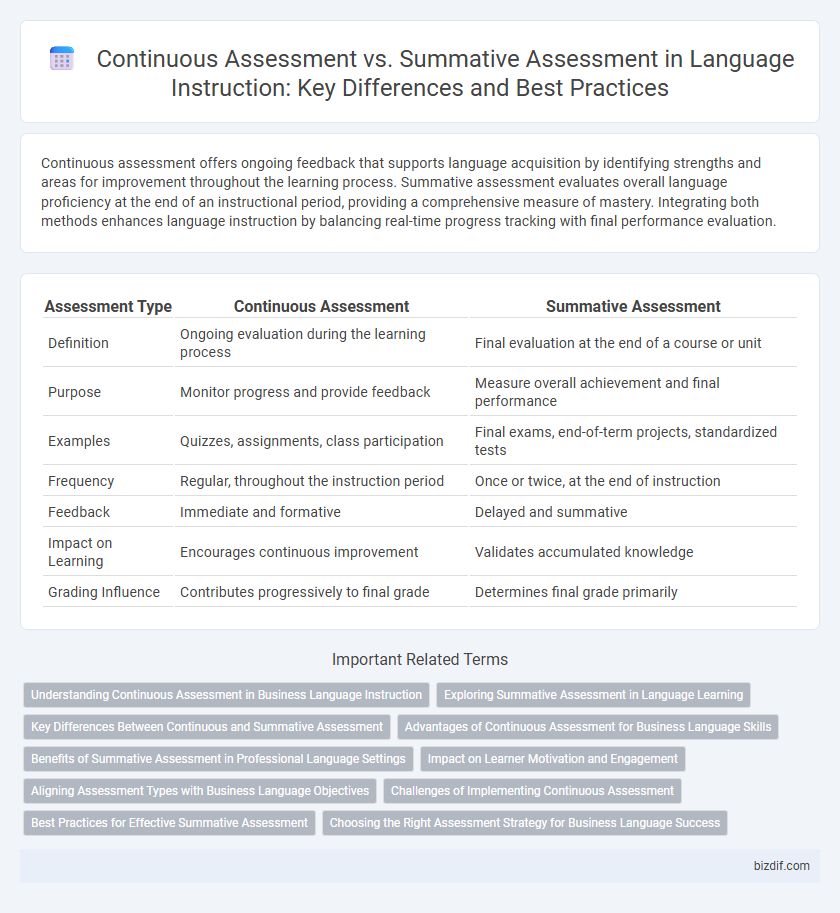Continuous assessment offers ongoing feedback that supports language acquisition by identifying strengths and areas for improvement throughout the learning process. Summative assessment evaluates overall language proficiency at the end of an instructional period, providing a comprehensive measure of mastery. Integrating both methods enhances language instruction by balancing real-time progress tracking with final performance evaluation.
Table of Comparison
| Assessment Type | Continuous Assessment | Summative Assessment |
|---|---|---|
| Definition | Ongoing evaluation during the learning process | Final evaluation at the end of a course or unit |
| Purpose | Monitor progress and provide feedback | Measure overall achievement and final performance |
| Examples | Quizzes, assignments, class participation | Final exams, end-of-term projects, standardized tests |
| Frequency | Regular, throughout the instruction period | Once or twice, at the end of instruction |
| Feedback | Immediate and formative | Delayed and summative |
| Impact on Learning | Encourages continuous improvement | Validates accumulated knowledge |
| Grading Influence | Contributes progressively to final grade | Determines final grade primarily |
Understanding Continuous Assessment in Business Language Instruction
Continuous assessment in business language instruction emphasizes regular evaluation of learners' practical communication skills, promoting ongoing improvement through diverse tasks such as presentations, role-plays, and written assignments. This formative approach provides immediate feedback, enabling instructors to tailor lessons to individual proficiency levels and real-world workplace scenarios. Unlike summative assessment, which measures cumulative knowledge at course end, continuous assessment fosters active engagement and skill development essential for effective business communication.
Exploring Summative Assessment in Language Learning
Summative assessment in language learning evaluates students' overall proficiency after instruction, typically through final exams or standardized tests measuring reading, writing, listening, and speaking skills. It provides clear benchmarks of language competency and proficiency levels aligned with frameworks such as the CEFR (Common European Framework of Reference for Languages). By analyzing summative assessment results, educators can identify strengths and gaps in language acquisition, informing curriculum adjustments and targeted interventions.
Key Differences Between Continuous and Summative Assessment
Continuous assessment involves regular evaluation of student performance through quizzes, assignments, and class participation, promoting ongoing feedback and learning improvement. Summative assessment typically occurs at the end of an instructional period, such as final exams or standardized tests, measuring overall achievement and knowledge retention. Key differences include the timing, frequency, and purpose: continuous assessment supports formative feedback and learning adjustments, while summative assessment evaluates cumulative competence.
Advantages of Continuous Assessment for Business Language Skills
Continuous assessment offers real-time feedback on learners' business language proficiency, enabling targeted improvements in communication, negotiation, and writing skills essential for professional success. It promotes consistent engagement with practical language tasks, fostering better retention and application of terminology and cultural nuances in business contexts. This formative approach helps identify specific skill gaps early, allowing for tailored instruction that enhances overall language competence and workplace readiness.
Benefits of Summative Assessment in Professional Language Settings
Summative assessment in professional language settings provides a clear measure of language proficiency, ensuring employees meet specific linguistic standards crucial for effective communication. It offers a standardized evaluation that supports objective decision-making in hiring, promotions, and training needs. The conclusive results help organizations identify skill gaps and allocate resources efficiently for targeted language development programs.
Impact on Learner Motivation and Engagement
Continuous assessment fosters sustained learner motivation and engagement by providing frequent feedback and opportunities for improvement, which encourages active participation and self-regulation. Summative assessment, focused on final outcomes, may heighten anxiety and reduce intrinsic motivation due to its high-stakes nature. Effective language instruction integrates continuous assessment to enhance motivation and engagement throughout the learning process.
Aligning Assessment Types with Business Language Objectives
Continuous assessment enhances learner engagement by providing ongoing feedback aligned with specific business communication goals, enabling real-time adjustments to language instruction. Summative assessment measures overall proficiency at the end of a course, ensuring that learners meet predefined business language standards essential for professional contexts. Aligning these assessments with clear business language objectives optimizes skill acquisition relevant to workplace performance and effective communication.
Challenges of Implementing Continuous Assessment
Implementing continuous assessment faces challenges such as increased teacher workload and the need for consistent and objective grading criteria to ensure reliability. It requires ongoing data collection and analysis, which can strain resources in underfunded educational settings. Ensuring student engagement and preventing assessment fatigue also complicate the effective use of continuous assessment methods.
Best Practices for Effective Summative Assessment
Effective summative assessment best practices emphasize clear alignment with learning objectives, use of diverse evaluation methods, and timely feedback to accurately measure student achievement. Employing rubrics and standardization enhances consistency and fairness across assessments, allowing educators to identify knowledge gaps and inform future instruction. Integrating technology and data analytics also supports comprehensive performance tracking and improves the overall validity of summative assessments.
Choosing the Right Assessment Strategy for Business Language Success
Continuous assessment provides ongoing evaluations through quizzes, presentations, and portfolio reviews, allowing real-time feedback that enhances language retention and practical application in business settings. Summative assessment, such as final exams or end-of-course projects, measures overall proficiency and mastery of business language skills at a specific endpoint. Selecting the right assessment strategy depends on the learning objectives, with continuous assessment supporting skill development and summative assessment verifying competence for professional communication effectiveness.
Continuous assessment vs Summative assessment Infographic

 bizdif.com
bizdif.com